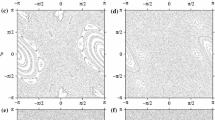Abstract.
This article reports a sudden chaotic attractor change in a system described by a conservative and dissipative map concatenation. When the driving parameter passes a critical value, the chaotic attractor suddenly loses stability and turns into a transient chaotic web. The iterations spend super-long random jumps in the web, finally falling into several special escaping holes. Once in the holes, they are attracted monotonically to several periodic points. Following Grebogi, Ott, and Yorke, we address such a chaotic attractor change as a crisis. We numerically demonstrate that phase space areas occupied by the web and its complementary set (a fat fractal forbidden net) become the periodic points' “riddled-like” attraction basins. The basin areas are dominated by weaker dissipation called “quasi-dissipation”. Small areas, serving as special escape holes, are dominated by classical dissipation and bound by the forbidden region, but only in each periodic point's vicinity. Thus the crisis shows an escape from a riddled-like attraction basin. This feature influences the approximation of the scaling behavior of the crisis's averaged lifetime, which is analytically and numerically determined as 〈τ〉∝(b-b0)γ, where b0 denotes the control parameter's critical threshold, and γ≃-1.5.
Similar content being viewed by others
References
C. Grebogi, E. Ott, J.A. Yorke, Phys. Rev. Lett. 48, 1507 (1982); C. Grebogi, E. Ott, J.A. Yorke, Physica D 7, 181 (1983)
C. Grebogi, E. Ott, J.A. Yorke, Phys. Rev. Lett. 57, 1284 (1986); C. Grebogi, E. Ott, J.A. Yorke, Phys. Rev. A 36, 5365 (1987)
C. Grebogi, E. Ott, J.A. Yorke, Phys. Rev. Lett. 50, 935 (1983); C. Grebogi, E. Ott, J.A. Yorke, Ergod. Theor. Dynam. Sys. 5, 341 (1985)
J. Wang, X.L. Ding, B. Hu, B.H. Wang, J.S. Mao, D.R. He, Phys. Rev. E 64, 026202 (2001)
J. Wang, X.L. Ding, B.H. Wang, D.R. He, Chin. Phys. Lett. 18, 13 (2001)
X.M. Wang et al., Eur. Phys. J. D 19, 119 (2002)
Y.M. Jiang, Y.Q. Lu, X.G. Chao, D.R. He, Eur. Phys. J. D 29, 285 (2004)
Y. He, Y.M. Jiang, Y. Shen, D.-R. He, Phys. Rev. E 70, 056213 (2004)
C. Mira, Inter. J. Bifur. Chaos 6, 893 (1996)
C. Grebogi, S.W. McDonald, E. Ott, J.A. Yorke, Phys. Lett. A 99, 415 (1983); S.W. McDonald, C. Grebogi, E. Ott, J.A. Yorke, Physica D 17, 125 (1985)
F.T. Arecchi, R. Badii, A. Politi, Phys. Rev. A 29, 1006 (1984); F.T. Arecchi, A. Califano, Phys. Lett. A 101, 443 (1986)
F.C. Moon, Phys. Rev. Lett. 53, 962 (1984); F.C. Moon, G.-X. Li, Phys. Rev. Lett. 55, 1439 (1985); E.G. Gwinn, R.M. Westervelt, Phys. Rev. A 33, 4143 (1986)
J.C. Alexander, J.A. Yorke, Z. You, I. Kan, Int. J. Bifur. Chaos 2, 795 (1992); E. Ott, J.C. Alexander, I. Kan, J.C. Sommerer, J.A. Yorke, Physica D 76, 384 (1994); P. Ashwin, J. Buescu, I.N. Stewart, Phys. Lett. A 193, 126 (1994); P. Ashwin, J. Buescu, I.N. Stewart, Nonlinearity 9, 703 (1996); J.F. Heagy, T.L. Carroll, L.M. Pecora, Phys. Rev. Lett. 73, 3528 (1994); Y.-C. Lai, C. Grebogi, Phys. Rev. E 52, R3313 (1995); H. Nakajima, Y. Ueda, Physica D 99, 35 (1996); L. Billings, J.H. Curry, E. Phipps, Phys. Rev. Lett. 79, 1018 (1997); K. Kaneko, Phys. Rev. Lett. 78, 2736 (1997); Y.L. Maistrenko, V.L. Maistrenko, A. Popovich, E. Mosekilde, Phys. Rev. E 57, 2713 (1998); T. Kapitaniak, Y. Maistrenko, A. Stefanski, J. Brindley, Phys. Rev. E 57, R6253 (1998); M. Woltering, M. Markus, Phys. Rev. Lett. 84, 630 (2000)
Y.-C. Lai, C. Grebogi, J.A. Yorke, S.C. Venkataramani, Phys. Rev. Lett. 77, 55 (1996)
Y.C. Lai, D.-R. He, Y.M. Jiang, Phys. Rev. E 72, 025201(R) (2005)
J. Dai, W.X. Wang, Y.M. Jiang, Y. He, W. Chen, D.-R. He, Chin. Phys. Lett. 22, 827 (2005); J. Dai, W.X. Wang, Y.M. Jiang, Y. He, W. Chen, D.-R. He, Chin. Phys. 14, 1334 (2005)
Author information
Authors and Affiliations
Corresponding author
Rights and permissions
About this article
Cite this article
Chao, XG., Dai, J., Wang, WX. et al. A semi-dissipative crisis. Eur. Phys. J. D 40, 423–430 (2006). https://doi.org/10.1140/epjd/e2006-00168-1
Received:
Published:
Issue Date:
DOI: https://doi.org/10.1140/epjd/e2006-00168-1



